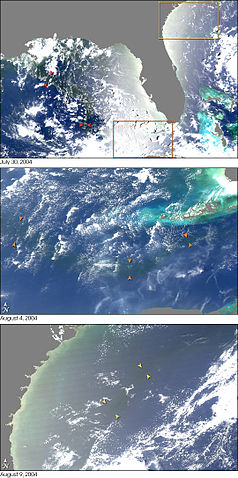 |
This is a file from the Wikimedia Commons. Information from its description page there is shown below.
Commons is a freely licensed media file repository. You can help.
|
Summary
| DescriptionMississippiRiver GulfMex MODIS 2004jul-aug.jpg |
English: Freshwater flowing off the land surface into the ocean is rich in nutrients and organic matter that influence the biology of the ocean—everything from seagrasses, to coral reefs, to single-celled ocean plants called phytoplankton. In terms of freshwater flow, the Mississippi River is the United States’ major contributor, draining over 40 percent of the U.S. land surface and ranking 8th in the world in terms of volume of water discharged to the ocean. But what happens to the water when it enters the Gulf of Mexico? In the summer months, a large portion of the Mississippi River outflow heads southeast into the Gulf of Mexico. In summer 2004, scientists combined satellite images of the Gulf of Mexico and the Atlantic Ocean with ship-based measurements of salt content and water chemistry to track the spread of a large plume of Mississippi River freshwater into the Gulf of Mexico and beyond. The Moderate Resolution Imaging Spectroradiometer (MODIS) images shown here follow the freshwater plume in late July and early August. The freshwater from the Mississippi appears as a dark ribbon against the lighter-blue surrounding waters. The images demonstrate that the plume did not mix with the surrounding sea water immediately. Instead, it stayed intact as it flowed through the Gulf of Mexico, into the Straits of Florida, and entered the Gulf Stream. The Mississippi River water rounded the tip of Florida and traveled up the Southeast coast to the latitude of Georgia before finally mixing in so thoroughly with the ocean that it could no longer be detected by MODIS. The images were captured by the MODIS on NASA’s Aqua satellite on (top to bottom) July 30, August 4, and August 9.
Français : Ces trois images-satellite montrent successivement le courant d'eau douce du Mississipi à proximité de son embouchure, au large des côtes de Floride, enfin de celles de Géorgie : sa trace demeure presque intacte à l'entrée du Golfe du Mexique, ne se diluant qu'au large de la Géorgie.
|
| Date |
July 30, 2004 to August 9, 2004 |
| Source |
http://earthobservatory.nasa.gov/Newsroom/NewImages/images.php3?img_id=17040 |
| Author |
Jesse Allen, NASA Earth Observatory |
Permission
( Reusing this file) |
Public domain.
|
Licensing
| Public domainPublic domainfalsefalse |
 |
This file is in the public domain because it was solely created by NASA. NASA copyright policy states that "NASA material is not protected by copyright unless noted". (See Template:PD-USGov, NASA copyright policy page or JPL Image Use Policy.) |
|
|
|
Warnings:
- Use of NASA logos, insignia and emblems are restricted per US law 14 CFR 1221.
- The NASA website hosts a large number of images from the Soviet/ Russian space agency, and other non-American space agencies. These are not necessarily in the public domain.
- Materials based on Hubble Space Telescope data may be copyrighted if they are not explicitly produced by the STScI. See also {{ PD-Hubble}} and {{ Cc-Hubble}}.
- The SOHO (ESA & NASA) joint project implies that all materials created by its probe are copyrighted and require permission for commercial non-educational use.
- Images featured on the Astronomy Picture of the Day (APOD) web site may be copyrighted.
|
File usage
The following pages on Schools Wikipedia link to this image (list may be incomplete):
Wikipedia for Schools is designed to make learning fun and easy. Our 500 Children's Villages provide a home for thousands of vulnerable children. Beyond our Villages, we support communities, helping local people establish better schools and delivering effective medical care to vulnerable children. There are many ways to help with SOS Childrens Villages.





